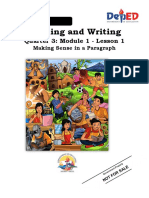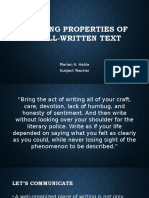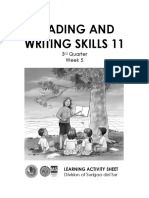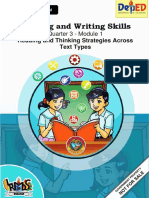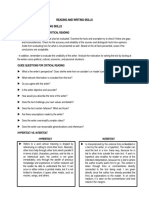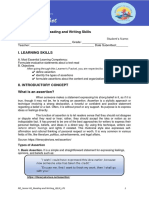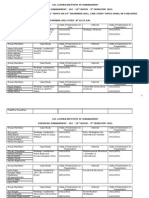Senior High School - Reading and Writing Skills
Senior High School - Reading and Writing Skills
Uploaded by
ADONIS & CherylCopyright:
Available Formats
Senior High School - Reading and Writing Skills
Senior High School - Reading and Writing Skills
Uploaded by
ADONIS & CherylOriginal Description:
Original Title
Copyright
Available Formats
Share this document
Did you find this document useful?
Is this content inappropriate?
Copyright:
Available Formats
Senior High School - Reading and Writing Skills
Senior High School - Reading and Writing Skills
Uploaded by
ADONIS & CherylCopyright:
Available Formats
SENIOR HIGH SCHOOL – Reading and Writing Skills
Student’s Name: _____________________________ Grade: _________________
Teacher: ___________________________________ Date Submitted: __________
I. LEARNING SKILLS
A. Most Essential Learning Competency:
Identify the unique features of and requirements in composing texts that are useful across
disciplines like book review or article critique
B. Objectives
1. Identify the unique features of book review or article critique
2. Compose a book review or article critique
II. INTRODUCTORY CONCEPT
If you are used to reading weekend-released newspapers you may have come across
articles that determine the merits and drawbacks of books. We call it book review or article
critique. Book review is a form of literary criticism in which a book is objectively analyzed,
evaluated, and commented on based on content, style and merit. Its purpose is to provide an
informed analysis that will help potential readers decide whether to read or not the book being
evaluated.
Similarly, article critique analyzes and comments on an article or text instead of the
entire book. Though “critique’’ may have negative connotation, it includes merit recognition,
since article critique can be part of book review. In this learner’s packet, we shall treat them
as one.
Elements of Book Review or Article Critique
Book review or critique may contain some or all of the elements below.
1. Summary. It summarizes in detail the main ideas and important contents of the book.
2. Reviewer’s statement. The reviewer explicitly states his thesis where his review will
focus on. He will then thoroughly discuss his thesis statement relating his analysis of the
work.
3. Brief Biographical Sketch. It gives a short biographical sketch of the intellectual life of
the author and relates his background to the book for review.
4. Relevance to other works. A discussion must be provided by the reviewer whether the
book under review has relevance to previous works of the writer or has it any similarities
or differences to other works in the field.
5. Objective evaluation. Objective evaluation must be clearly presented and well
supported. Every statement of the reviewer must be supported
with explanation and excerpt from the text reviewed.
6. Quotations. Selected quotations from the book under review
may be used to represent the theme, tone and style.
RO_Senior HS_Senior HS_Reading and Writing_Q2/4_LP3.1 1
The Structure
In formal writing, such as book review or critique, organization is always an element to
consider. Organization in your book review may be achieved by interweaving the elements
mentioned above. This will help the review to be clear, focused, logical and effective. This
structure may be adopted.
Title. Starts the book review or critique with a striking title. Do not use the same title as work
for review, though it may be included. Your readers must have a sense of work’s content and
reviewer’s perspective.
Introduction. Introduces the bibliographical information of the book for review. It also includes
a general statement from the reviewer that indicates the work’s content and reviewer’s reaction
to it. This statement usually serves as the thesis statement of the review.
Body. Contains the summary of the work for review, purpose of the book and evaluation. Each
will be at least one paragraph. The length of the review varies with the extent of what to say
and the nature of the review.
Summary. Emphasizes the important points of the writer. It should state the overall impression
of the book.
Purposes of the book state in the foreword or introduction. Author’s background may be
included to establish connection with previous works.
Evaluation discusses the negative and positive features of the book for review. Your judgment
as a reviewer must be clear and must be supported with evidence from the work especially
when you challenge the assumption of the writer. This may be done through paraphrasing and
quoting excerpts from the material.
Conclusion. Restates the overall impression of the book. No new information must be
included. Explain why you recommend or not recommend the book. Some review structures
include rating, but this is optional.
Why is book review important?
While writers and book lovers enjoy the importance of book review, senior high school
students begin to appreciate it after finishing this learner’s packet. Book reviews save reader’s
time. With the book reviewer presenting the features of the book, it shortens the time of
decision-making on whether to read the book or not. It also decreases
risk to readers. Potential readers become familiar with what a book is all
about and it gives them the idea of how they might react to it. Book
reviews give books greater visibility and greater chance of being found
by more readers. Compared to books with few or no reviews, reviewed
books are likely recommended for reading. Online book clubs, blogging
communities and bookstores amplify reviews thus, increase popularity of
reviewed books. Reviews help increase sales. The more reviews the
book has, the more it increases its popularity. Its popularity makes more
people curious and interested to buy it. However, some authors are
taking advantage of this by making their own book review. This is
unethical.
RO_Senior HS_Senior HS_Reading and Writing_Q2/4_LP3.1 2
III. ACTIVITIES
A. PRACTICE TASKS
Practice Task 1. Let Us Review
Read the Book Review sample of Caroline Hau’s ‘Tiempo Muerto’. Study how the
reviewer, Ruel S. De Vera, developed his review of the novel “Tiempo Muerto” and answer
the questions that follow on your answer sheets.
Caroline Hau’s ‘Tiempo Muerto’ is a powerful first novel that explores distance and
identity
By: Ruel S. De Vera Philippine Daily Inquirer / 04:01 AM January 20, 2020
1On the scarred surface, Lia Agalon and Racel Panindagat can’t have anything in common
save for their location. At the beginning of Caroline Hau’s “Tiempo Muerto: A Novel '' (Bughaw-
Ateneo de Manila University Press, Quezon City, 2019, 275 pages) the two are still both in
Singapore. Lia is the daughter of a wealthy Filipino family married to a wealthy Singaporean
executive and Racel is an overseas Filipino worker working as a nanny for the Wong family.
2But it turns out the two are connected in powerful ways—Hau constructs the connections
one artery at a time. Lia’s story is told in third person; Racel is the daughter of Lia’s own nanny,
Yaya Alma and tells her story in first person. The two alternate chapters share a past on the
fictional location of Banwa Island.
3 “Tiempo Muerto” kicked into motion when the two returned to the Philippines, sent into
motion by telephone calls. Racel must hurry home because her mother has gone missing. Lia
escapes Singapore after a divorce due to a tabloid-exposed affair with her personal trainer.
They return to Manila first, and, of course, eventually back to Banwa.
4But not yet. Racel and Lia must go on journeys of their own, forward and back, before what
is obviously going to be a fateful meeting.
5In the meantime, there is a lot of story to be told. As Racel says: “Most of what I know my
mother told me; the rest I make up.”
6As Racel returns to Banwa in search for her mother, she increasingly becomes aware of
just how little she knew about Nanay, especially after Racel had left for Singapore: “It does
not surprise me that Nanay has been martyred and canonized over and over. I do not know
this stranger. To me, she is just Nanay.”
7Despite sharing the narrative with Lia, Racel is clearly the dominant character and narrator.
It is through her that the reader more heavily navigates the mined sugarcane field of memories
and questions within “Tiempo Muerto,” some of them resonate to this day.
Dead season
8The novel takes its name from the tiempo muerto, the “dead season” between
planting and harvesting, when sugarcane workers go hungry because they have no paid
work: “Our stomachs understood the difference between pain and hunger. We knew what it
was like year after year, to walk the purgatory between life and death.”
RO_Senior HS_Senior HS_Reading and Writing_Q2/4_LP3.1 3
9Hau is a respected writer of literary history and criticism; she has also written two excellent
collections of short fiction, 2015’s “Recuerdos de Patay and Other Stories” and 2019’s
“Demigods and Monsters.”
10The issues and techniques she deployed in those collections are in full force, in
conjunction, in her debut novel. Banwa Island is very much a character by itself. There is a lot
touched on in between Racel and Lia’s stories: the heart-wrenching OFW experience, the
death of marriages, the possible haunting of a balay daku, indoctrination, oppression, a long-
delayed slow-burn romance, family tensions and the turbulence of the Marcos years: “The
dead season of 1985 was different, for the demons had come unshackled and roved the
countryside,” Racel recalls. “Turning Banwa into an inpierno for the living.”
11It explores the nature of distance and identity between people. Yet it works because Hau
doesn’t miss a thing. There is an unusually clinical quality to Hau’s prose, but instead of putting
you off, you just wind up admiring these obviously carefully constructed complicated doll
houses of plot. There are entire pages of just details piled on top of each other, but they’re
never over-written, and perfectly balanced. Incidentally, Hau had included the Agalons in a
previous short story. Can we call the connective space between all her stories the Hau-verse?
12By the time Lia and Racel inevitably meet toward the end of “Tiempo Muerto,” readers will
know they have experienced something extraordinary, the coming
together of two characters who had been so far away from each other yet never really apart
over all these years and miles. Those connections were more powerful than you imagined or
dreaded. This is a powerful debut novel from Caroline Hau. There is just so much story in
“Tiempo Muerto” that one is reminded of Nanay Alma’s admission to her confused daughter:
“You can leave whenever you want to, but as the years grow heavy, you feel as if you no
longer have any choice.”
Source:https://lifestyle.inquirer.net/355673/caroline-haus-tiempo-muerto-is-a-powerful-first novel-thatexplores-
distance-and-identity/#ixzz6RrKlssYt
1. Do you think the setting Banwa Island is in
existence in real life? Why?
2. What does the writer mean when he said “walk the
purgatory between life and death’?
3. Based on the review, what do you think is the
theme of the novel by Hau?
RO_Senior HS_Senior HS_Reading and Writing_Q2/4_LP3.1 4
Practice Task 2. Elements In Review.
Refer to the Book Review in Practice Task 1. Fill in the table below by writing the
paragraph numbers where an element of review or critique can be found. Also identify the
elements observed. Do this on a different sheet of paper.
Paragraph or Line Number Element
Practice Task 3. Remembering the Book.
Remember the book you recently read. Take note of the details from cover to the end
of the book. Answer the guide questions on the first column. On the third column write your
comment or opinion on items you find significant to comment on. Do this on a different
sheet of paper.
Book Features Answer Comment/Opinion
On features
What is the title of the book?
Does the title suggest
anything?
Is the title of the book
adequate to its content?
Who wrote the book?
When was it published?
What is the relevance of the cover
illustration to the topic
of the book?
Book type
What type of book is it?
Fiction or non-fiction?
What genre does it
represent?
On contents
Are there charts, graphs, photographs,
etc.?
What does the photographs
show?
RO_Senior HS_Senior HS_Reading and Writing_Q2/4_LP3.1 5
Do they have something to do with the
theme of the book?
Do the photographs reveal something
about the author?
What does the material
present?
On topic
What is the general topic of the book?
What is the author’s main arguments?
What did the author want to accomplish?
What message did the
author want to convey?
Why was the book written?
On writing style
Is the author’s writing style technical or
simple?
Is it logical or emotional?
How did the writer reveal the character?
On readership
Who is the intended reader of the book?
Are the terms and
vocabulary appropriate to the readers?
Practice Task 3. Let’s Check!
Fill in the blank with appropriate words that will complete the statement. Write your
answer on a separate sheet of paper.
1. After a thorough evaluation of the book, the reviewer may decide to give a _____________
of the book to potential readers to influence them to read the material.
A. analysis B. recommendation C. commendation D. visibility
2. In the book review organization, the bibliographical information is usually placed in the
_________________.
A. summary B. body C. introduction D. title
3. Book review helps reduce _______________ to potential readers on how they react to the
content of the book.
A. time B. sales C. visibility D. risk
4. One importance of book review is that it shortens the decision ________ because the
reviewer had presented the features of the book.
A. making B. risk C. time D. visibility
5. It is _______________ for the author himself to make a review of his own book just to gain
popularity and to boost sales.
A. ethical B. unethical C. distinction D. interesting
6. Although the word __________ always has a negative connotation, it also gives
merit to the work not purely criticizes the book or article for review.
A. article B. criticism C. critique D. comment
RO_Senior HS_Senior HS_Reading and Writing_Q2/4_LP3.1 6
7. Clear presentation of your analysis with quotations and excerpts from the text helps create
an objective _________________.
A. comment B. evaluation C. review D. opinion
8. A book usually caters a particular group of people as its _______________.
A. readership B. audience C. on-lookers D. spectators
9. The _____________ highlights the intellectual life of the author. It gives authority to the
reader.
A. biographical sketch B. background C. journey D. experience
10. __________________ has no place in the book review. Suggestions or proposals may be
addressed to the author but must be clearly stated.
A. prejudices B. anger C. recommendation D. impartiality
B. ASSESSMENT
You have now reached the final level of learning about book
review. To demonstrate how well you are able to understand
the lesson, write a well-written book review or critique of a
book or an article you have read and post it in our Reading
and Writing Class FB Page. Be guided by the rubric below.
IV. RUBRIC FOR
SCORING
RO_Senior HS_Senior HS_Reading and Writing_Q2/4_LP3.1 7
This rubric is adapted from https://www.wintonwoods.org/userfiles/557/AGS/Summer%20Assignments/Rubric%20for%2
0book%20review.pdf
V. ANSWER KEY
Practice Task 1.
Answers may vary
Practice Task 2.
Paragraph
or Line Element Used Explanation
Number
Title Reviewer’s Statement Though the format is unusual, for me the
or Thesis title is considerably a thesis statement. It
is not found in the introduction nor in the
body. However, it was restated in the last
part.
Paragraph Bibliographical The title of the book review is in itself
1 information considerably as a thesis statement. In the
first paragraph, while Ruel S. De Vera
introduces the characters in the novel, he
mentioned the bibliographical notes of the
book for review.
Paragraph Summary The preceding paragraphs noted the
2, 3, 4, 5, significant events in the lives of the main
6 characters Lia and Rachel. However, De
Vera immediately discontinued his
suspenseful narration by quoting Rachel.
Obviously, he wanted his readers to
discover for themselves what other
RO_Senior HS_Senior HS_Reading and Writing_Q2/4_LP3.1 8
revelations will take place in the story. He
disclosed the fact that the main characters
do not know much about the other
character whom they are acquainted with.
Also, De Vera mentioned his evaluation of
who is the dominant character in the novel
by analyzing the narrative.
Paragraph Objective Evaluation The writer talks about who the dominant
7&8 character is and on paragraph 8, he
disclosed the translation and the
significance of the title of the novel for
review. He related the relevance of the
title with a quotation which may be taken
from the selection.
Paragraph Biographical Sketch This part mentions the brief biographical
9 sketch of the writer. He mentioned the
previous works of the author.
Paragraph Relevance to other De Vera restated his thesis statement
10 works which can be found in the title itself. He
supported his statement with instances
from the novel and his analysis of Hau’s
narrative style. He even connected Hau’s
novel with her previous work asking the
readers if it can be called Hau-verse.
Practice Task 3.
Answers may vary
Assessment
Answers may vary
VI. REFLECTION/ COMMENTS/ SUGGESTIONS
_____________________________________________________
_____________________________________________________
_____________________________________________________
_____________________________________________________
_____________________________________________________
_____________________________________________________
_____________________________________________________
_____________________________________________________
_____________________________________________________
RO_Senior HS_Senior HS_Reading and Writing_Q2/4_LP3.1 9
VII. REFERENCES
Websites:
https://www.utsc.utoronto.ca/twc/sites/utsc.utoronto.ca.twc/files/resource-
files/CriticalReading.pdf
https://www.tcc.edu/wp-content/uploads/archive/writing-center-handouts/essay-types-book-
review-critique-guidelines.pdf
https://advice.writing.utoronto.ca/wp-content/uploads/sites/2/book-review.pdf
https://www.utsc.utoronto.ca/twc/sites/utsc.utoronto.ca.twc/files/resource-
files/CriticalReading.pdf
https://www.dudleycourtpress.com/book-reviews/
https://lifestyle.inquirer.net/355673/caroline-haus-tiempo-muerto-is-a-powerful-first-novel-
that-explores-distance-and-identity/#ixzz6RrKlssYt
Prepared by:
RONALD M. MANDANE – Teacher III
Tingco National High School
SDO – Sorsogon Province
ROCHELLE F. DIONEDA – Master Teacher I
Barcelona National Comprehensive High School
SDO – Sorsogon Province
Layout Artist:
LEMUEL F. DE RAMON – Teacher II
Bulusan National High School
SDO – Sorsogon Province
Quality Assured by:
MARICEL M. DINEROS
Education Program Supervisor-English
SDO – Sorsogon Province
JECER L. JESORO
San Antonio National High School
SDO – Iriga City
CLAUDIA MARILOU S. MARPURI
Education Program Supervisor-English
SDO – Iriga City
RO_Senior HS_Senior HS_Reading and Writing_Q2/4_LP3.1 10
You might also like
- FREE ALGOs EzOscillatorv.4Document6 pagesFREE ALGOs EzOscillatorv.4AbidNo ratings yet
- SENIOR HIGH SCHOOL-English For Academic and Professional PurposesDocument8 pagesSENIOR HIGH SCHOOL-English For Academic and Professional Purposesjoshua herreraNo ratings yet
- Lesson 4 Patterns of DevelopmentDocument56 pagesLesson 4 Patterns of Developmentkim villete100% (1)
- 20 Things Great Dads Do Every DayDocument11 pages20 Things Great Dads Do Every Dayozan gökoğluNo ratings yet
- SENIOR HIGH SCHOOL-Reading and Writing Skills: A. Most Essential Learning CompetencyDocument9 pagesSENIOR HIGH SCHOOL-Reading and Writing Skills: A. Most Essential Learning CompetencyADONIS & CherylNo ratings yet
- SENIOR HIGH SCHOOL-Reading and Writing Skills: A. Most Essential Learning CompetencyDocument9 pagesSENIOR HIGH SCHOOL-Reading and Writing Skills: A. Most Essential Learning CompetencyADONIS & CherylNo ratings yet
- Q3 SHS Reding - W LAS 8Document7 pagesQ3 SHS Reding - W LAS 8Beata Virgo Maria75% (4)
- CV Sisgp 2022 - 2023 3Document4 pagesCV Sisgp 2022 - 2023 3Med Amine0% (1)
- RWS11 Q2 W1&2Document12 pagesRWS11 Q2 W1&2Crisanta CañeteNo ratings yet
- Book Review or Article CritiqueDocument61 pagesBook Review or Article CritiqueCielo Gariando100% (2)
- SMILE Reading and Writing Q2 LP3.2Document11 pagesSMILE Reading and Writing Q2 LP3.2ADONIS & Cheryl50% (4)
- Methods of Philosophizing: Week 4 - Module 2.2Document21 pagesMethods of Philosophizing: Week 4 - Module 2.2Janna GunioNo ratings yet
- Eapp Month 1Document62 pagesEapp Month 1ᜃᜎᜐ᜔ᜆᜒ100% (1)
- Explicit and Implicit Claims, and Context of Text DevelopmentDocument21 pagesExplicit and Implicit Claims, and Context of Text DevelopmentAileen MallariNo ratings yet
- Grade: Critical Reading As A Form of ReasoningDocument8 pagesGrade: Critical Reading As A Form of ReasoningFrancineNo ratings yet
- Reading and Writing: Ma. Evalou Concepcion A. Agustin Aurelio G. Alfonso Edd Victor M. Javeña EddDocument11 pagesReading and Writing: Ma. Evalou Concepcion A. Agustin Aurelio G. Alfonso Edd Victor M. Javeña EddCarlos Samson100% (1)
- SHS Eapp Q4 Las 1Document8 pagesSHS Eapp Q4 Las 1Aster JadeNo ratings yet
- RWS q4 Mod4 Hypertext-And-Intertext CleanDocument28 pagesRWS q4 Mod4 Hypertext-And-Intertext CleanChrissel TabasaNo ratings yet
- Creative Writing Week4 8Document31 pagesCreative Writing Week4 8Brielle ManuelNo ratings yet
- WK5 Q1 Oct.1121 Writing The Reaction PaperDocument21 pagesWK5 Q1 Oct.1121 Writing The Reaction PaperHanna Shane EsplanaNo ratings yet
- Applied12 EAPP Q3 W4 LeaPDocument6 pagesApplied12 EAPP Q3 W4 LeaPJanna Gunio67% (6)
- English For Academic and Professional Purposes: Quarter 1 - Module 2, Week 2Document16 pagesEnglish For Academic and Professional Purposes: Quarter 1 - Module 2, Week 2Cristina Luz Cabana100% (1)
- Creative Nonfiction Q2-M12Document15 pagesCreative Nonfiction Q2-M12charlenemagdayaoNo ratings yet
- Distinguishes Between and Among Patterns of Development in Writing Across DisciplinesDocument41 pagesDistinguishes Between and Among Patterns of Development in Writing Across DisciplinesAries Sunga100% (1)
- 1 Q3 Shs RWS PatternsofdevelopmentDocument6 pages1 Q3 Shs RWS PatternsofdevelopmentJoan Marie N. Pamilaran100% (1)
- Reding and Writing Reg. Module - JosephDocument17 pagesReding and Writing Reg. Module - JosephMayet Alunsagay-Delos Reyes100% (1)
- Applying Properties of A Well-Written TextDocument54 pagesApplying Properties of A Well-Written TextMarian A. Habla82% (17)
- Reading and Writing: Department of EducationDocument17 pagesReading and Writing: Department of Educationjohn paul dioneoNo ratings yet
- Republic of The Philippines Department of Education Region VII, Central Visayas Division of Bohol English For Academic and Professional PurposesDocument3 pagesRepublic of The Philippines Department of Education Region VII, Central Visayas Division of Bohol English For Academic and Professional PurposesCecille Hernando93% (15)
- Reading and Writing: Department of EducationDocument15 pagesReading and Writing: Department of EducationRicardo Acedo Jr.100% (1)
- Reading and Writing PDFDocument108 pagesReading and Writing PDFDarioz Basanez Lucero100% (1)
- Week 5 and 6 Explicit and Implicit Claims in Written TextsDocument2 pagesWeek 5 and 6 Explicit and Implicit Claims in Written TextsYvonne Cielo Siaron100% (1)
- Senior High School - Reading and Writing SkillsDocument6 pagesSenior High School - Reading and Writing SkillsADONIS & Cheryl0% (1)
- Hypertext & IntertextualityDocument5 pagesHypertext & IntertextualitySalve Serrano67% (3)
- Patterns of Development in Writing Across Disciplines: Reading and Writing SkillsDocument4 pagesPatterns of Development in Writing Across Disciplines: Reading and Writing SkillsMark Give De LeonNo ratings yet
- Epartment of Education: D Guipos National High School Poblacion Guipos, Guipos Zamboanga Del SurDocument7 pagesEpartment of Education: D Guipos National High School Poblacion Guipos, Guipos Zamboanga Del SurMyla Ebillo50% (2)
- (Q1) MODULE 9 - Concept PapersDocument20 pages(Q1) MODULE 9 - Concept PapersJewel SantiagoNo ratings yet
- Reading Writing Skills Q3 Week 5 Version 5Document12 pagesReading Writing Skills Q3 Week 5 Version 5Cristina Luz CabanaNo ratings yet
- Introduction To The Philosophy of The Human Person Holistic Perspective vs. Partial Point of View Quarter 1-Module 1 Pre-TestDocument28 pagesIntroduction To The Philosophy of The Human Person Holistic Perspective vs. Partial Point of View Quarter 1-Module 1 Pre-TestYuma YumaNo ratings yet
- Republic of The Philippines Department of Education City of San Jose Del Monte Bulacan Sapang Palay National Senior High SchoolDocument81 pagesRepublic of The Philippines Department of Education City of San Jose Del Monte Bulacan Sapang Palay National Senior High SchoolEricka Mae Manabat Herrera100% (2)
- RWS Q3 Module1Document39 pagesRWS Q3 Module1Dela Cruz, Aldrin S.No ratings yet
- Lesson 1 (Narrative)Document16 pagesLesson 1 (Narrative)Amabelle Labitag100% (3)
- Module 2 Quarter 3 - 4.docx Version 3 FINALDocument100 pagesModule 2 Quarter 3 - 4.docx Version 3 FINALangeli50% (4)
- Crative Writing F 12 - Module Sept 7-11Document4 pagesCrative Writing F 12 - Module Sept 7-11Roz Ada86% (7)
- M 7Document21 pagesM 7Gray Vades100% (2)
- Week 4, Q1-Parenas-Creative Nonfiction-12, Eval Es-editedSomosaDocument16 pagesWeek 4, Q1-Parenas-Creative Nonfiction-12, Eval Es-editedSomosaIvy Mae SagangNo ratings yet
- BoondocksDocument18 pagesBoondocksYrrech Lane100% (9)
- Practical Research I: Quarter 1 - Module 2Document16 pagesPractical Research I: Quarter 1 - Module 2Marvin M Pulao75% (8)
- Properties of A Well-Written Text: Language Use: Reading and Writing Skills Miss Hazel Angelyn E. TesoroDocument26 pagesProperties of A Well-Written Text: Language Use: Reading and Writing Skills Miss Hazel Angelyn E. TesoroAngel Amor GaleaNo ratings yet
- READING AND WRITING SKILLS WEEK 1and 2 MODULES AND ACTIVITESDocument16 pagesREADING AND WRITING SKILLS WEEK 1and 2 MODULES AND ACTIVITESAkira MashitoNo ratings yet
- Learning Activity Sheet English For Academic and Professional Purposes 11Document27 pagesLearning Activity Sheet English For Academic and Professional Purposes 11Dave Billona100% (1)
- Paraphrasing Skill: By. Ulfa Rahmi, S. Si, M. EdDocument19 pagesParaphrasing Skill: By. Ulfa Rahmi, S. Si, M. EdIndah Maharani Nasution100% (2)
- Reading Strategies-ACTIVITYDocument3 pagesReading Strategies-ACTIVITYDiana Mamaril100% (2)
- Properties of A Well-Written TextDocument83 pagesProperties of A Well-Written TextMaryknoll GC78% (9)
- Lesson 7 Identifying and Analyzing ClaimsDocument11 pagesLesson 7 Identifying and Analyzing ClaimsConnieRoseRamosNo ratings yet
- Reading and Writing Skills: Patterns of Development in Writing Across DisciplinesDocument21 pagesReading and Writing Skills: Patterns of Development in Writing Across DisciplinesRony Caratao Bargas0% (1)
- Patterns of Development in Writing 2Document59 pagesPatterns of Development in Writing 2Marc Oliver Nabablit100% (1)
- Definition Paragraph - Writing ActivityDocument1 pageDefinition Paragraph - Writing ActivityJenalyn Bugaay0% (1)
- Report in Reading and Writing 11Document6 pagesReport in Reading and Writing 11Mae EnteroNo ratings yet
- Summary Lesson For Creative Non FictionDocument12 pagesSummary Lesson For Creative Non FictionFGacadSabado100% (1)
- Directions: in This Activity, You Are Tasked To Read The List of Words orDocument10 pagesDirections: in This Activity, You Are Tasked To Read The List of Words orZarah Joyce Segovia100% (1)
- Statement of ConventionDocument9 pagesStatement of ConventionJude Ayo Naparate100% (1)
- EAPP-LAS-4 English EAPP 12Document5 pagesEAPP-LAS-4 English EAPP 12DYLANNo ratings yet
- Q4 9 Shs Readingandwriting Bookreview v1Document16 pagesQ4 9 Shs Readingandwriting Bookreview v1DONABEL ESPANONo ratings yet
- ResearchDocument19 pagesResearchADONIS & CherylNo ratings yet
- Reading and Writing Summative SUMMATIVE 1 Q2Document3 pagesReading and Writing Summative SUMMATIVE 1 Q2ADONIS & CherylNo ratings yet
- SENIOR HIGH SCHOOL-Reading and Writing SkillsDocument8 pagesSENIOR HIGH SCHOOL-Reading and Writing SkillsADONIS & CherylNo ratings yet
- SENIOR HIGH SCHOOL-Reading and Writing SkillsDocument8 pagesSENIOR HIGH SCHOOL-Reading and Writing SkillsADONIS & CherylNo ratings yet
- Senior High School - Reading and Writing SkillsDocument6 pagesSenior High School - Reading and Writing SkillsADONIS & Cheryl0% (1)
- SMILE Reading and Writing Q2 LP1Document7 pagesSMILE Reading and Writing Q2 LP1ADONIS & CherylNo ratings yet
- SM Cec 2011Document4 pagesSM Cec 2011Khushi L SosaNo ratings yet
- Jimma University College of Social Science and Law Department of English Language and LiteratureDocument26 pagesJimma University College of Social Science and Law Department of English Language and Literaturekassahun mesele100% (1)
- Cambridge English Empower Empower B1 Reading Plus Teacher U07 WorksheetDocument1 pageCambridge English Empower Empower B1 Reading Plus Teacher U07 WorksheetSara AljoozNo ratings yet
- Im Not Sure British English TeacherDocument15 pagesIm Not Sure British English TeachermixxNo ratings yet
- Student A Opinion PostDocument3 pagesStudent A Opinion Postapi-377854628No ratings yet
- Mastering Astronomy Homework 8 AnswersDocument5 pagesMastering Astronomy Homework 8 Answerscfdbw9a0100% (1)
- Group Decision Support SystemDocument18 pagesGroup Decision Support SystemMudit BhargavaNo ratings yet
- Nola PenderDocument17 pagesNola PenderGiorgetteNo ratings yet
- Hannan BelanisoDocument44 pagesHannan BelanisoBecca NapilNo ratings yet
- CorelDraw X7 Deployment Guide 05Document41 pagesCorelDraw X7 Deployment Guide 05Shaikh FuzenNo ratings yet
- LukoseDocument2 pagesLukoseapi-599457980No ratings yet
- ITTRENDS100Document3 pagesITTRENDS100Laine BlaireNo ratings yet
- Madhyasth Darshan - 8th Sem OE 3 - 80 Student - C GroupDocument3 pagesMadhyasth Darshan - 8th Sem OE 3 - 80 Student - C GroupSHUVANSHU GUPTANo ratings yet
- Half Range Sine and Cosine SeriesDocument18 pagesHalf Range Sine and Cosine Seriesdurgesh351287No ratings yet
- Widya Ratna Karakteristik Dan Pola Pergerakan Penduduk Di Kawasan Pinggiran Kota YogyakartaDocument7 pagesWidya Ratna Karakteristik Dan Pola Pergerakan Penduduk Di Kawasan Pinggiran Kota YogyakartaarNo ratings yet
- Using Metaphors in Education: Studied Metaphors in Our Education, But Even Without Realizing It, Those of Us InvolvedDocument4 pagesUsing Metaphors in Education: Studied Metaphors in Our Education, But Even Without Realizing It, Those of Us InvolvedSonia MiminNo ratings yet
- logo ក្រសួង អប់រំ - Google SearchDocument1 pagelogo ក្រសួង អប់រំ - Google SearchKîî WîîNo ratings yet
- Class DirectoryDocument10 pagesClass DirectorySean Kristopher AcuñaNo ratings yet
- Test Bank Interpersonal Relationships Professional Communication Skills For Nurses 8th Edition ArnoldDocument3 pagesTest Bank Interpersonal Relationships Professional Communication Skills For Nurses 8th Edition ArnoldDaniel Davis100% (37)
- Waste Management Among The Senior Highschool Students inDocument8 pagesWaste Management Among The Senior Highschool Students inYami Light IINo ratings yet
- A Detailed Lesson Plan in English 4Document5 pagesA Detailed Lesson Plan in English 4gwen orteaNo ratings yet
- L1.4 Using Past PapersDocument2 pagesL1.4 Using Past PapersCaesius ChenNo ratings yet
- Additional Chapter 2022Document395 pagesAdditional Chapter 2022Sani YakubuNo ratings yet
- DenisDocument3 pagesDenisapi-519707018No ratings yet
- Module TR1 FINAL PDFDocument114 pagesModule TR1 FINAL PDFMar Stone100% (1)
- Jordan Savoie - Resume 2023Document2 pagesJordan Savoie - Resume 2023api-572416863No ratings yet
- NMRS - Form DOLEDocument2 pagesNMRS - Form DOLENataCoNo ratings yet























